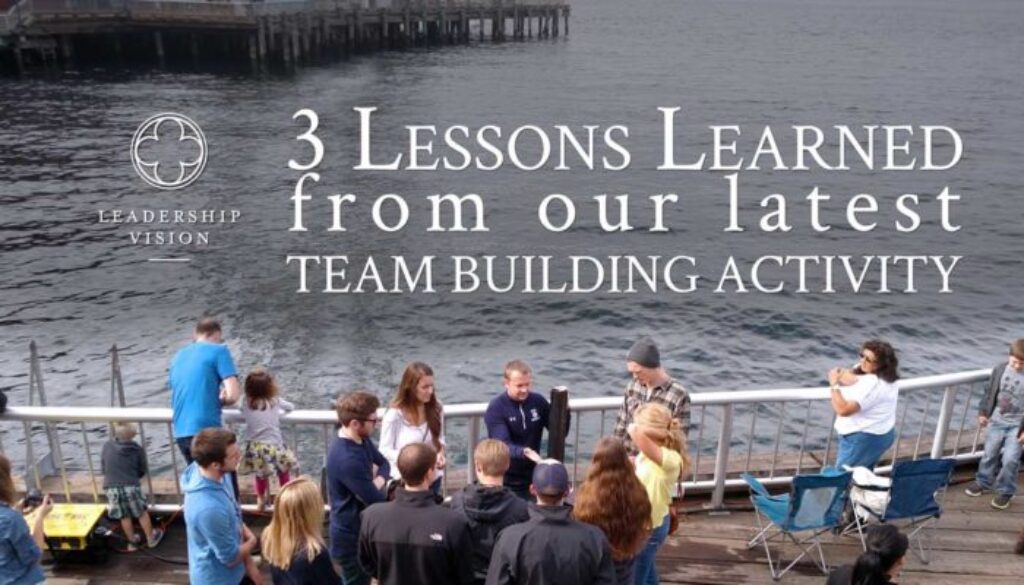3 Lessons Learned During our Latest Team Building Activity
When working in a team environment, one of the hardest things to do is work on that team. What I mean is, often we get so bogged down by the tasks of the day, we don’t take time to focus on what makes us strong, what frustrates us, and where we could learn from one another.
Recently we were in Seattle working with a group of college student leaders. Their academic year had just begun, so most of them were relatively new with their current team. On this particular trip, we were conducting our Vision Trekk team building experience. This allows us to observe a team’s interaction, while making specific application to leadership, innovation, and their individual and team Strengths.
Vision Trekk is especially fun in a University setting because of the energy students bring. Our team also applies this same engagement with non-profits and large corporations. Reflecting on what makes this team building such an effective tool for seeing the behaviors behind Strengths, here are three things that make this universally applicable for exploring Strengths.
1. It all Comes down to Perspective
Whether you are a 21-year-old college junior, or a 51-year-old vice president at a Fortune 500 company, people fundamentally face the same challenges when working in a team environment.
We encourage our clients to go through some type of experiential activity around Strengths as it forces issues to come up and be talked about before becoming massive problems when the stakes are higher.
This is why understanding the perspective of your colleagues is so important for good team dynamics. Are you willing and able to understand someone else’s perspective? The language of Strengths is a great way to do this.
At the end of the Vison Trekk, we intentionally debrief to allow for reflection and observation. In this most recent session, one student made the comment that he wanted to win. Nobody on his team seemed to share this perspective, so the whole day was difficult for him. He had the Strength of Competition, so it was an easy point to talk about later.
Another team had someone who sort of ‘checked out’. When asked about this, she said she couldn’t “keep up with the fast pace.” She had several thinking themes, and prefers more time to make decisions, and wasn’t comfortable in the “run and go” activities of the day.
Both of these examples provided an opportunity to learn from and understand other team members.
Ask Yourselves these Questions
- How do I help other people understand my perspective?
- What can I do to understand others perspective?
2. Adaptability isn’t just a Strength… it’s a Necessary Skill Leaders Need
The best leaders find a way to “get the job done.” A good leader finds ways to adapt and adjust when something isn’t going as planned. Adaptability as a Strength may have an easier time with this, but everyone can use their Strengths themes to find alternate ways of doing things.
It is impossible to plan for every contingency. Since we were working with a large group of university students, we had several new people helping us. As I was providing instruction on how to complete the Vision Trekk challenges, they were asking lots of good questions, trying to anticipate everything that could happen. Ultimately, I tried to empower them to make their own decisions and use their best judgement in the moment. As long as they kept the goal of what we were trying to accomplish in their mind, they could use their own creativity to complete the challenges.
Sara did a great job of this.
One of the locations we planned to use was filled with people waiting in line for a soup kitchen. Probably 100 people crowded into a small city park. Rather than move to another location, she kept the challenge there, and worked around (and, in some cases, with) those curious about what we were doing. It was uncomfortable, but she used the resources of our team to make it work. For some of the students, this forced them to think more about how their own Strengths “adaptiveness” could be used to get them back into the moment.
Ask Yourselves these Questions
- When things don’t go as planned, what is your first instinct? Find a way around, or quit?
- How do your themes of Strength play into that decision?
3. Pressure is usually a Good Thing
When you put pressure on a group, however arbitrary, it helps motivate and focus a team to get a task done. This sense of urgency often forces more creativity because there isn’t the luxury to brainstorm. You have to try something and if it doesn’t work, try something else.
A funny example of how this happened was during the water leak challenge. As the students began, a large group of tourists gathered to watch. Assuming it was some sort of Seattle street performance, they stood there eagerly waiting to see what would happen.
There was cheering, there was laughter, but most of all, the dozens of extra sets of eyes made this challenge more difficult as the students felt the stakes were higher.
Ask Yourselves these Questions
- How do you react to situations when the pressure is on?
- How do your themes of Strength bring life to you and others when you are stressed?
Now What?
As you reflect on these questions from our team building activities, think about ways you can engage your Strengths this week so they will generate positive outcomes. Share what you are going to do below.





